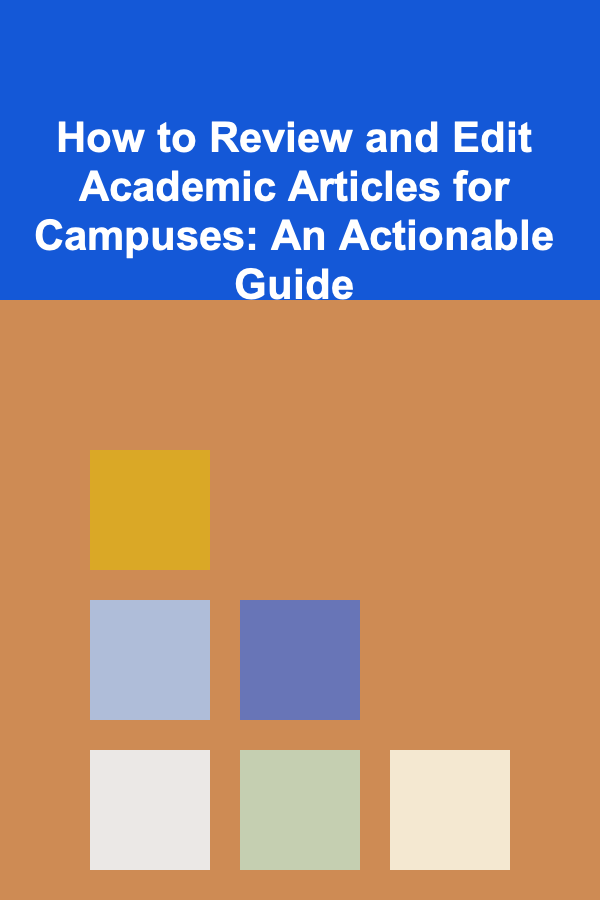
How to Review and Edit Academic Articles for Campuses: An Actionable Guide
ebook include PDF & Audio bundle (Micro Guide)
$12.99$10.99
Limited Time Offer! Order within the next:

Reviewing and editing academic articles is an essential part of academic work, particularly for faculty, researchers, and students in university settings. Whether you're reviewing a peer's article for a journal, editing a thesis or dissertation, or providing feedback for academic publications on campus, the process can be both daunting and rewarding. This actionable guide will walk you through how to effectively review and edit academic articles, ensuring your feedback is constructive, clear, and valuable to the writer.
Understand the Purpose of the Article
Before diving into the nitty-gritty of reviewing and editing, it's important to grasp the purpose of the article you're working with. Understanding the context of the research, the target audience, and the objectives of the article will shape how you approach the review and editing process.
Key Considerations:
- Purpose of the Research: Is the article aiming to present new findings, review existing literature, or propose a theoretical framework?
- Target Audience: Who will read this article? Is it aimed at specialists in the field, or is it meant for a broader academic audience?
- Journal or Conference Requirements: If you're reviewing for a journal or conference, familiarize yourself with the publication's submission guidelines and scope to ensure the article aligns with their requirements.
Actionable Tip:
Before reviewing, make sure you have a clear understanding of the article's thesis statement and research question. This clarity will help you evaluate whether the author stays focused on the central argument and contributes meaningfully to the field.
Read the Article Thoroughly
The first step in the review process is to read the article in its entirety. Don't rush through it---give yourself the time to understand the content deeply. As you read, take notes, highlight key points, and make mental or written notes about areas that need attention.
Actionable Tips:
- Initial Read-Through: Read the article once without making any marks or edits. Just focus on getting a general sense of the flow and structure of the article.
- Take Notes: On your second read, take notes on specific points that seem unclear, unsupported, or overly complex. Record areas where you think the article needs improvement, such as gaps in the argument or unclear explanations.
- Highlight Critical Passages: Highlight passages that seem especially strong or weak. This can help you focus your edits later on.
Evaluate the Structure and Organization
Once you have a good sense of the article's content, it's time to evaluate the structure and organization. A well-organized article is essential for clear communication of ideas. Check if the article follows the general structure of academic papers: introduction, literature review, methodology, results, discussion, and conclusion.
Areas to Focus On:
- Clarity of the Introduction: Does the introduction clearly state the research problem and its significance? Is the thesis or research question well-defined?
- Logical Flow: Are the sections logically connected? Does each paragraph transition smoothly to the next? Check if the article flows in a coherent manner from one section to another.
- Conclusion: Does the conclusion summarize the key findings of the research and propose avenues for future work?
Actionable Tip:
If any section of the article seems disjointed or lacks coherence, suggest reorganization or better transitions between ideas. Ensure that the introduction sets the stage effectively for the body of the paper and that the conclusion ties back to the research questions posed.
Assess the Argumentation and Evidence
The core of any academic article lies in its argumentation. A strong academic article presents a well-supported argument with clear evidence. During your review, assess whether the arguments are sound, logically structured, and supported by credible sources.
Questions to Ask:
- Is the Argument Clear?: Can you easily follow the author's argument from start to finish? Are there any contradictions or ambiguities that need to be addressed?
- Support for Claims: Are the claims in the article substantiated by evidence? Does the author cite relevant studies or data to back up their points?
- Critical Analysis: Does the article engage critically with the literature? Is there a discussion of alternative perspectives, and does the author acknowledge the limitations of their own research?
Actionable Tip:
If any claims are unsupported or unclear, provide specific suggestions on how the author could better substantiate their arguments, such as recommending additional sources or data.
Check for Clarity, Precision, and Style
An academic article should be written in a clear, precise, and formal style. The language should be appropriate for the target audience, and sentences should be concise and easy to understand. As you review the article, focus on language clarity, conciseness, and tone.
Areas to Focus On:
- Sentence Structure: Are the sentences clear and easy to read? Avoid long, convoluted sentences that may confuse the reader.
- Word Choice: Is the language precise, or are there vague or ambiguous terms that need clarification?
- Consistency in Terminology: Does the author consistently use the same terms or concepts throughout the paper? Inconsistent terminology can confuse readers.
Actionable Tip:
If you find any awkward or unclear phrasing, suggest rewording or breaking up overly long sentences. Ensure that technical terms are well-defined when first introduced.
Grammar, Punctuation, and Formatting
One of the most straightforward tasks in editing is to check for grammatical errors, punctuation issues, and overall formatting. These mistakes can detract from the professionalism of the article and reduce its clarity.
Areas to Check:
- Grammar and Syntax: Are there any subject-verb agreement issues, misplaced modifiers, or awkward sentence constructions?
- Punctuation: Ensure proper use of commas, periods, semicolons, colons, and quotation marks. Misuse of punctuation can change the meaning of a sentence.
- Formatting Consistency: Does the article adhere to the specified formatting guidelines (e.g., font size, margins, citation style)?
Actionable Tip:
Make use of grammar-checking tools like Grammarly or Hemingway Editor, but also conduct a manual check for subtler issues. Ensure that the article follows the appropriate citation style (APA, MLA, Chicago, etc.) and that references are correctly formatted.
Evaluate the Citation and Reference List
The reference list is an essential part of any academic article. It provides the sources that support the arguments made within the article and ensures that proper credit is given to prior work. Review the citations and references to ensure they are accurate and complete.
Key Areas to Check:
- Accuracy: Are the in-text citations correct? Do the references listed match the sources cited within the text? Ensure that every reference is accurate and complete.
- Adherence to Citation Style: Are all citations and references formatted according to the required style guide? Ensure consistency in formatting (e.g., author names, article titles, journal names, page numbers).
- Current Sources: Are the references up-to-date? In some fields, using outdated sources can detract from the credibility of the paper.
Actionable Tip:
Cross-check each reference in the list with the citation in the body of the article. Pay attention to details like author names, publication years, and titles. Suggest adding more recent or relevant sources if necessary.
Provide Constructive Feedback
As you review and edit the article, always keep in mind that the goal is to improve the work, not to criticize the author personally. Offer constructive feedback that helps the writer enhance their article without discouraging them.
Strategies for Constructive Feedback:
- Be Specific: Instead of vague comments like "The argument is weak," provide specific examples and suggest ways to strengthen the argument.
- Balance Criticism with Praise: Point out what the author has done well, as well as areas for improvement. This creates a more balanced and motivating feedback experience.
- Tone: Ensure that your feedback is respectful and encouraging. Remember that academic writing is a skill that improves with practice.
Actionable Tip:
When providing feedback, use the "sandwich" method---start with positive comments, address areas for improvement, and end with more positive feedback. This helps ensure the review is constructive and motivating.
Final Review and Proofreading
After completing the review and edits, take a step back and do a final proofreading of the article. This is the last chance to catch any lingering errors or areas that could be further improved.
What to Look for in Final Proofreading:
- Typographical Errors: Look for any lingering typos or misspelled words.
- Repetitive Phrasing: Ensure there's no unnecessary repetition of words or phrases.
- Final Read-Through: Read through the article one last time to ensure that it flows smoothly and is ready for submission or publication.
Actionable Tip:
Consider reading the article aloud. This can help you catch awkward phrasing, missing words, and other errors that might be missed when reading silently.
Conclusion
Reviewing and editing academic articles requires careful attention to detail, a deep understanding of the subject matter, and a commitment to constructive feedback. By following this actionable guide, you can provide valuable insights to help improve the quality of academic writing and contribute to the development of scholarly work on campus. Whether you're working on your own writing or reviewing others, the process of editing is an essential skill that helps enhance clarity, precision, and overall quality in academic articles.

How to Create a Shipping and Logistics Checklist for Managing Returns
Read More
How to Organize Your Fishing Gear for Easy Access
Read More
Why You Should Set Up a Routine for Managing Outgrown Clothes
Read More
How to Invest in Preferred Stocks
Read More
How to Conquer Your Fear of Deep Water
Read More
Understanding Language Dialects: A Comprehensive Guide
Read MoreOther Products

How to Create a Shipping and Logistics Checklist for Managing Returns
Read More
How to Organize Your Fishing Gear for Easy Access
Read More
Why You Should Set Up a Routine for Managing Outgrown Clothes
Read More
How to Invest in Preferred Stocks
Read More
How to Conquer Your Fear of Deep Water
Read More